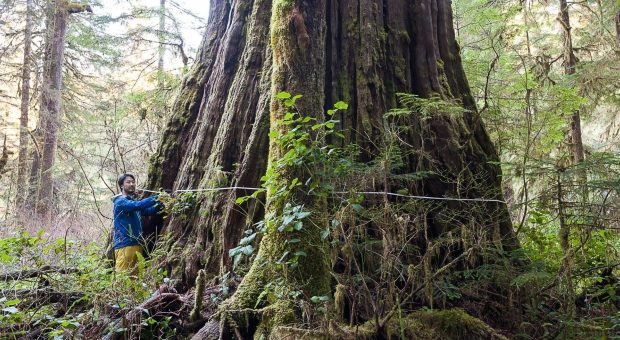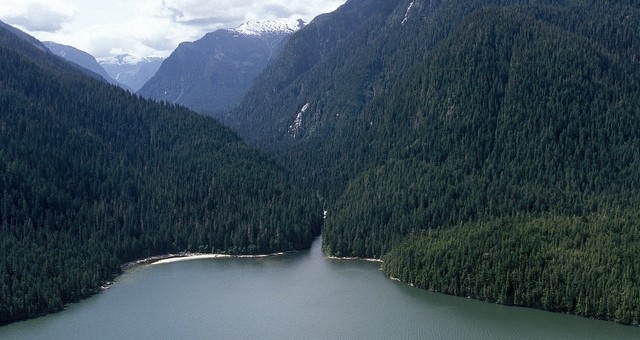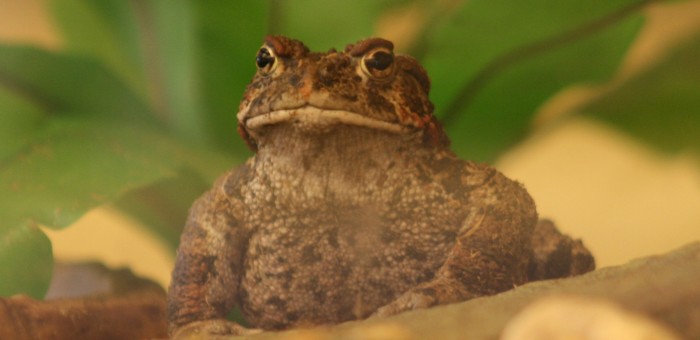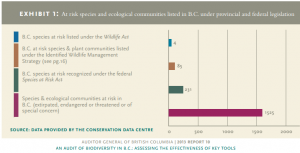Forests
Reinvesting in British Columbia’s Forest Sector
Despite today’s announcement that $150 million will be invested in reforestation, a wave of unemployment is sweeping across rural B.C. because of government policies that have devastated the province’s once-great forest resource.
Premier Christy Clark now says the appropriate response is to put forest industry people to work building roads and bridges. B.C. really needs a bigger vision than that – especially since the provincial government is complicit in the sector’s mismanagement in the first place.
In the late 1990’s and early 2000’s, a pine beetle infestation erupted. The pandemic was exacerbated by successive B.C. NDP and Liberal governments who pursued policies that created largely monoculture forests. Pine trees grow fast and the government encouraged their use as the “preferred” species for replanting huge swaths of land that had been clear-cut. At the same time, the government’s shortsighted forest fire suppression policies snuffed out fires that would have naturally created a more diversified landscape. (Forest fires play a vital ecological role and, where possible, should be monitored closely but left to safely burn.)
The result: huge plantations of pine trees flourished. As climate change reduced the severity of B.C. winters, they became perfect breeding grounds for pine beetles and the largest beetle attack ever seen in North America was unleashed destroying millions of trees over a massive area. As the epidemic spread, and the health of B.C.’s forests deteriorated, the government was forced to dramatically increasing the allowable cut.
In recent years, the decline of the province’s forests has been masked by the increased cutting of dead trees in so-called salvage logging – but there is no hiding the fact that nearly 60% of the merchantable pine has been destroyed by the beetle invasion. Today, even the dead trees are running out and across rural B.C. forest industry jobs have entered a period of rapid, devastating decline.
Recent labor force statistics show that while the number of jobs in Metro Vancouver are up, there has been a drop in rural B.C. The unemployment rate in Mainland/Southwest B.C. is at 5%, but it is 8.2% in Thompson-Okanagan and 10.5% in North Coast/Nechako. In December, Tolko Industries shut down its Nicola Valley sawmill, taking 203 high-paying jobs out of a small community that will struggle without them.
And that’s just the start of it.
Because of the declining timber supply, the province’s chief forester has been forced to reduce the allowable annual cut (AAC). In Prince George, the AAC is being reduced by 50%. In Quesnel the AAC is dropping to 1.6 million cubic metres from 4 million cubic metres. Last March, in the Merritt Timber Supply Area, the AAC was cut to 1.5 million from 2.4 million cubic metres.
If you reduce the number of trees being cut, there will be a corresponding drop in the number of loggers, truck drivers and mill workers who have jobs. The Truck Loggers Association recently heard at its annual convention that five or six pulp and paper mills will close in the next two to six years. Thousands of jobs will be lost.
Over the past 25 years, NDP and Liberal governments’ have tried to position themselves as defenders of the forest industry, by setting the AAC at unsustainable levels, instead of concentrating on value added and diversification. The consequences of this are now coming home to roost. Premier Clark’s plan to increase spending on infrastructure projects to address the economic divide between rural and urban B.C. may deliver much needed infrastructure but will not create a long term solution.
What rural B.C. really needs are healthy forests and a vibrant small/medium family business culture that can provide sustainable logging, support local economies and provide environmental diversity over the long term. That’s how communities grow and prosper.
We need to rethink our forest management in the context of the realities of the 21st century – global warming; technological change; international competition; not to mention the immediate issues of growing protectionism, and the soft wood lumber dispute. Our tenure structures date back to the 19th century, and our mills have been starved of investment over recent years. The investment that has taken place, has usually replaced people with machines.
Rather than manage our forests, the BC Liberals have toyed with privatizing them. It is worth remembering that in 2001, Mike De Jong, then Minister of Forests, told a meeting of silviculturalists that BC’s Crown forests would be “unrecognizable” when he and the Liberals were finished with them.
Our forests are our collective asset, and we need to ensure that first and foremost, British Columbians are fully benefiting from them, not just corporations and vested interests.
We need to start a new conversation about our forests. We need to ask:
- How do we maximize the benefits of our forest industry?
- How do we get the greatest value from our fibre?
- How do we ensure that our rural and remote communities are included in the benefits?
- What is the most effective long term management structure?
- How do we integrate indigenous people and communities in decision making?
- How are we going to manage sustainability, long term productivity, mitigating climate change and enhancing secondary manufacturing?
A redesign of our forest management is long overdue and would be priority of a BC Green Government. We need to truly end the war in the woods, and ensure that our forests work for all of us.
Protecting Vancouver Island’s Old Growth Forest
Question period in the legislature today was surreal. I left the chamber wondering whether I should quit politics altogether. I was absolutely appalled by the behaviour of official opposition and government members. It was shocking — truly shocking.
Personal attacks, vitriol, abuse, obnoxious heckling and utter disrespect was on display for all to see. This place needs to change. It needs a complete shake up.
That won’t happen, it seems, unless the general public rises up to vote out those politicians on both sides of the house who are more interested in hurling abuse than dealing with issues facing British Columbians. There was no excuse for the behaviour today. No excuse at all.
I was up on question period today and had planned to ask the relevant Minister two questions. The Minister was not at Question Period so I had to be nimble and ask a completely different question (see next post).
The question I had planned to ask is reproduced below. It was meant to coincide with an announcement on the need for widespread protection of old-growth forests on Vancouver Island.
We have lost over 90% of our biggest and most productive low-elevation old-growth forests. The government is continuing to allow the harvesting of our old-growth forests on Vancouver Island based on a plan created in the 1990s. It’s time to create a plan for this century.
The reality is, the government will say they are ‘protecting’ old-growth forests when in reality they have largely protected the steep, high mountain slopes or wet bogs. Yes it’s technically old-growth, but it’s the valley bottom, low-elevation, highly productive old-growth forests with the massive thousand-year-old trees that are at greatest risk.
In 2013 the UVic Environmental Law Centre proposed an “Old Growth Protection Act”. Part of this science-based plan was to immediately end old-growth logging in critically endangered forests and to quickly phase out old-growth logging where there is a high risk to biological diversity and ecosystem integrity. I believe the idea has merit.
Aside from ensuring habitat and biodiversity integrity, protecting our old-growth forests in British Columbia should be a part of our province’s climate plan. On Vancouver Island, apart from reducing our emissions, one of the most significant things we can do to for the climate is to leave our old-growth forests intact. It is also the responsible thing to do for our eco-tourism industry and follows the wishes of local communities across this island.
In April the Association of Vancouver Island Coastal Communities passed R11 – a resolution calling for increased protection of old-growth forests on Vancouver Island.
The Walbran Valley is the one of the most concerning productive old-growth forests but there are a number of old-growth areas that are or could be logged any day including: Nootka Island, East Creek, Edinburgh Grove, Tsitika Valley, Nahmint Valley, Southwest Nimpkish, Echo Valley, Maclaughlin Ridge, Horne Mountain, and the Cameron Valley Fire Break. In my view there is no compelling reason to justify the logging the last of our productive old-growth forests.
Background Facts
- On Vancouver Island 90% of the biggest and most productive low-elevation old-growth forest has been removed
- Only 13% of the land base on Vancouver Island is protected from logging, only 8% of the island’s productive forest ecosystems are protected, and just 3% of the valley-bottom rainforests are protected.
- A recent report from the Wilderness Committee calls for a conservation plan for Vancouver Island’s rainforest where ½ of Vancouver Island’s rainforest is set aside
- Old-Growth forests are substantially better carbon sinks than young forests. According to a new study in the journal Nature, a tree’s growth accelerates with age, enabling them to take up more carbon than younger trees.
- In 2013 the University of Victoria’s Environmental Law Centre proposed an “Old Growth Protection Act” to ensure better protection for BC’s ancient forest heritage.
- They called for a science-based plan that would have immediately ended old-growth logging in critically endangered forests and phased out old-growth logging where there is a “high risk to biological diversity and ecosystem integrity”.
- Calvin Sandborn, legal director of the Uvic Environmental Law Centre, stated at the time that “there is a need for new legislation and planning that is based on science, governed by timelines, and plugs existing loopholes or inconsistencies.”
- While there is an old-growth management strategy currently in place, it is heavily skewed towards protecting areas of low productivity (e.g. mountain tops and steep slopes)
- The Association of Vancouver Island Coastal Communities 2016 R11 resolution stated the following:
“be it further resolved that AVICC send a letter to the provincial government—Minister of Forests, Lands and Natural Resource Operations—as well as relevant government organizations requesting that the Vancouver Island Land Use Plan be amended to protect all of Vancouver Island’s remaining old growth forest on provincial Crown land.”
Question
While I’m pleased with government’s announcement today that they’re going to protect 186,198 hectares of already-protected old growth forest on the mainland, on Vancouver Island, our old growth forests are in dire need of protection. The Wilderness Committee and Sierra Club have called what’s happening here an ecological emergency.
Putting this in context, over 90% of the grandest and most productive low-elevation old-growth forests on Vancouver Island have already been logged. Only about 3% of the original high productivity, valley bottom old-growth forests are protected in parks and Old Growth Management Areas on BC’s Southern Coast. Several species are also on the brink of disappearing and biodiversity is being affected.
The Walbran Valley is one of a rapidly dwindling number of contiguous prime ancient forests left on Southern Vancouver Island large enough to provide habitat for healthy populations of a number of endangered species. Yet a 486-hectare core area of the valley is unprotected — a portion of it is slated for logging right now.
Is the Minister of Forests, Lands and Natural Resource Operations open to implementing an alternative science-based forest management system for Vancouver Island’s remaining intact old-growth forest?
Supplemental Question
Old growth forests are not only fundamental to the ecological integrity of Vancouver Island, they are also a major eco-tourism draw and many island communities have recognized this.
For example, Chambers of commerce and city councils from Tofino to Victoria have passed motions opposing the continued old-growth logging in the Walbran Valley.
Two weeks ago the Association of Vancouver Island and Coastal Communities endorsed a motion calling on the government to amend the Vancouver Island Land Use Plan to protect all of Vancouver Island’s remaining old growth forest found on provincial Crown Land. This land use plan was created in the 1990s and logging of old-growth forest has continued for the last two decades.
Will the government recognize that a plan formed in the 1990s is no longer adequate for today, listen to wishes of local communities and amend the Vancouver Island Land Use Plan to protect all remaining old-growth forests on crown land?
Endangered Wildlife — The Next Migration
Today I had the distinct honour of giving the keynote address at the opening of the Endangered Wildlife — The Next Migration art exhibit at the Robert Bateman Centre.
I took the opportunity to make two announcements. The first is that the we need to form a Natural Resource Board here in British Columbia — one that mirrors the Forest Practices Board and ensures that the cumulative effects of our resource extraction do not put species and ecosystems at further risk.
The second is that I am calling for an end to all old growth logging on crown land here on Vancouver Island.
This call comes in light of the motion put forward by the Association of Vancouver Island and Coastal Communities at their AGM on April 10th, 2016, which resolved that the old-growth forests on provincial Crown Land on Vancouver Island be protected from logging.
Below is the text of my speech.
Text of Speech
Good evening. First I would like to thank the Robert Bateman Centre and the organizers of this event from the University of Victoria’s Faculty of Education for inviting me tonight. I am honoured to speak to you and to have the chance to enjoy all of the magnificent artwork on display here. It is also a privilege to meet the talented artists that created these beautiful pieces.
Everyone here tonight would agree that we are extremely lucky to live in such a beautiful place. I truly believe we live in one of the most beautiful places in the world.
We are inspired by our natural environment and it is wonderful to be able to use that inspiration in order to highlight the environmental risks we face.
Having read through many of the artist’s biographies on the event’s site, it’s clear that each of these individuals has a profound connection with, and passion for, nature and wildlife. So it makes perfect sense that this passion would inspire their work. And as is true with any discipline, when passion and work can coexist and inspire one another, the potential for success is boundless.
In fact, the ability for two things to coexist in a harmonious and beneficial manner is exactly what we are here to celebrate and promote this evening.
According to the International Union for the Conservation of Nature (IUCN), humans have discovered an estimated 1,562,663 different lifeforms on this planet. Of these 1.5 million species – that include both animals and plants – 77,340 have been assessed by the IUCN Red List of Threatened Species.
According to the Red List, 22,784 of these assessed species are currently threatened with extinction. The loss and degradation of natural habitat has been identified as the main threat to 85% of all species identified on the list.
While these numbers portray the problem on a global level, our local circumstances are not much better. According to the David Suzuki Foundation, over 60% of British Columbia’s ecological areas, such as grasslands, and over 40% of our species are at-risk. That’s 1900 at-risk species not to mention the hundreds of ecosystems.
Under the federal Species at Risk act, a total of 231 species are listed as at-risk in this province, yet the BC government explicitly provides protection for only 4 of them (the Sea Otter, White Pelican, Burrowing Owl and Vancouver Island Marmot).
The reason for this discrepancy in protected species is largely due to the fact that there is currently no stand-alone provincial act to protect endangered species here in BC.
Despite having the greatest biodiversity in the country and numerous calls on government to do more to protect our wildlife, BC remains one of only two provinces in Canada – the other being Alberta – that has no Endangered Wildlife Act.
Instead, we’ve been hiding behind the outdated B.C. Wildlife Act, which was neither designed for this purpose nor provides the protection that these species need.
To add to the already fragile situation, we continue to put economic interests ahead of environmental ones, without realising that one cannot flourish without the other.
Without more government regulated oversight, the cumulative effects of climate change and human development will continue to have adverse and unprecedented impacts on all aspects of our natural environment.
There are a number of steps we can and should be taking to diminish the negative impacts we are having on our natural environment. This is especially true of government.
By addressing issues relating to climate change, resource extraction, old growth logging and preservation at a provincial level, we can take major strides towards ensuring that the biodiversity of our province remains healthy.
Climate change is perhaps one of the most serious threats to our natural environment as a whole. Unfortunately, our provincial government is failing to demonstrate any leadership in addressing this issue.
Due to the choices that our government has made since 2012, there is no longer a pathway to meet our legislated 2020 GHG reduction targets. Yet in response to this realization, the BC Liberal government has simply highlighted the need for a new 2030 target, with little offered about how we can get there. Setting targets is meaningless if the policy isn’t there to go along with it.
This approach puts BC at odds with the rest of the global community, who are calling for governments to take immediate action on addressing and mitigating climate change.
At a time when it is imperative that we are making meaningful investments in low carbon technologies, our leaders are pulling out all the stops to building fossil fuel infrastructure that will commit the province to an energy-intensive non-renewable industry for the foreseeable future.
BC has all the tools it needs to tackle climate change head on; we have the renewable resources required, and the innovative, creative, and inspired population. All that is missing is the leadership required to focus these efforts.
We need to stop trying to force through projects such as LNG and Site C and start supporting clean energy development.
We need to start paying attention to the consequences of rapid and poorly thought-out resource development, and I would argue to do so we need to form a Natural Resource Board here in British Columbia.
One that mirrors the Forest Practices Board and ensures that the cumulative effects of our resource extraction do not put species and ecosystems at further risk.
Another leading threat to species at-risk is the loss and degradation of habitat. And arguably one of the biggest contributing factors to habitat loss here in British Columbia is the logging of old-growth forests.
Just this past fall I received thousands of emails from citizens across the province expressing their concerns over planned logging in the Walbran Valley and other old growth forests on Vancouver Island.
Old growth forests provide many important environmental and social functions, serving as homes to numerous species at risk and as popular recreation areas for locals and tourists alike. They are essential for both ecosystem integrity and as substantial carbon sinks. It is time they receive a level of protection that reflects their importance to both our ecosystems and our economy.
To ensure this, it is necessary that we take an ecosystem-focused and science-based assessment in decisions concerning forestry and resource management, and I am concerned that this is not what is happening in our Province today.
Instead, by playing the environmental and social concerns off against economic ones, we are merely allowing an unsustainable status quo to continue.
Protecting our remaining old-growth forests while supporting our forest industry do not have to be competing objectives. It is time we take a closer look at the status quo in forestry management in our Province, and work to ensure that we consider at all factors – social, environmental and economic – when we are making decisions.
By ensuring the protection of old-growth forests we can help to protect countless wildlife populations in our province. We can stop pitting one species against another as a means of wildlife management and instead focus on the preservation of all species and ecosystems.
Take the case of the Woodland Caribou.
Last summer, British Columbia announced a controversial wolf cull as a means to protect the South Selkirk and South Peace mountain caribou populations, which are on the brink of extirpation (or local extinction). Now when you start rationalizing the culling one species to protect another you also introduce an ethical element that needs to be considered alongside science.
If you let one of those species become threatened because of your actions the situation becomes immensely worse. Ethically, the wolf cull is a horrible response to an ecosystem out of balance.
From a management perspective, we should be focusing on endangered mountain caribou and the logging practices that got them to where they are today.
Before humans began changing the North American landscape, the woodland caribou’s range extended across Canada. While northern subpopulations of caribou once roamed in massive herds numbering in the thousands, mountain caribou have always been more sparsely distributed. Mountain caribou survive on a lichen-rich diet, especially in winter months, a food source that is intricately linked to old growth forests.
As industrial development and logging activities began to fragment their old growth forest ecosystems, mountain caribou populations began to destabilize. Not only has logging demolished much of their habitat directly, the associated road networks and areas of new growth forest have also brought an influx of moose and white-tailed deer into the ecosystem.
Populations of wolves then followed the moose and deer (their primary prey) and caribou (their secondary prey) are now being killed as bycatch. We are scrambling to save herds of mountain caribou on the brink of extirpation because we weakened their natural habitat and made them vulnerable to increased predation.
Sadly, the future for these threatened caribou is not looking promising; climate change is altering food supplies and habitat conditions, industrial activities are unbalancing ecosystem composition, and human settlement is steadily encroaching on our natural wilderness. All of which serves to highlight the need for increased wilderness protection.
As per requirements enforced under Canada’s Species at Risk Act, the province has protected 2.2 million hectares of forest from logging and road building where populations of caribou are classified as threatened.
These areas have immeasurable value for preserving British Columbia’s biodiversity, especially in light of ongoing global warming. But these areas, a substantial fraction of which are old growth, also have substantial commercial value.
However, without provincial regulations to protect old-growth forests, I am concerned that vast tracts of forests will stop being preserved the moment the threatened caribou herds go extinct. With their death, the protection of their habitat will no longer be enforceable under the Species at Risk Act.
We need to protect as much land as possible from all human activities so remaining wildlife populations have the space and resources needed to respond to predation and food supply challenges.
With that in mind, as leader of the BC Green Party I am calling for an end to all old growth logging on crown land here on Vancouver Island.
This call comes in light of the motion put forward by the Association of Vancouver Island and Coastal Communities at their AGM on April 10th, 2016, which resolved that the old-growth forests on provincial Crown Land on Vancouver Island be protected from logging.
Biodiversity is already stressed by climate change, and human interaction – at least in the heavy-handed way that it exists today – simply acts to make it worse.
We need to start taking calculated and proven steps to lessen the negative impacts of human interaction and create a world in which people and wildlife can coexist in a harmonious and complementary way.
Thank you.
Photo Credit: TJ Watt, Ancient Forest Alliance
Bill 2 – 2016: Great Bear Rainforest (Forest Management) Act
Today in the Legislature I rose at second reading to speak in support of the historic Bill 2 – 2016: Great Bear Rainforest (Forest Management) Act. This bill is being supported by all parties. It provides the legislative changes required to enable the recent negotiated agreement between 26 First Nations, the province, non-government organizations and forest companies that protects vast areas of our Great Bear Rainforest.
Below are the text and video of my speech. Near the beginning a speech you will see that a class of grade 5 students from Vancouver were introduced by George Heyman, MLA for Vancouver-Fairview. It was a light moment for both sides of the house as we collectively greeted the students.
Text of my Speech
A. Weaver: It gives me great pleasure to rise with my colleagues on both sides of this House to support, as well, Bill 2, the Great Bear Rainforest (Forest Management) Act.
This is truly a remarkable event when we find 26 First Nations, the province of British Columbia, several — in fact, numerous — non-governmental organizations and forest companies coming together to reach an agreement in terms of what can be logged, what will be logged, what should not be logged and how logging should be done in an area on the west coast of our province known as the Great Bear Rainforest.
The bill before us, Bill 2…. Let’s be clear that this bill is really a bill about what can be logged, what can be cut. It leaves a lot, as we’re seeing from other bills, up to regulations that will be put forward through order-in-Council at some point in the future. I don’t want to diminish the importance of this bill, of course, but again, I want it to be very clear that what we are debating is what can be cut in the Great Bear Rainforest, rather than, in some sense, the ways in which we do cut or the overall ecosystem-based approach to forestry that’s being taken.
Let me also acknowledge that, as with any bill or any agreement, there will be those who think that government gave away too much. There will be those who think that government didn’t give away enough. There will be those environmental groups that think this was a sellout. There will be those environmental groups that think this is a great success.
This is true of every agreement that is made. But what’s important to recognize is that we were not at the table. Who was at the table? Well, 26 First Nations, a number of environmental groups and a number of forest companies. To get agreement on this is truly an important event.
G. Heyman: With respect to the member for Oak Bay–Gordon Head, I seek leave to make an introduction.
Leave granted.
Introductions by Members
G. Heyman: Thank you very much, and thank you to the member.
Joining us in the gallery above me today is a grade 5 class. In fact, the class is split in two from Talmud Torah School in Vancouver-Fairview. I met them at the door. They’re accompanied by teachers Lisa Romalis, Becky Chan and Nicole Andersen.
This is almost a school within a school. There are 75 grade 5 students. We had a very brief discussion about the bill that we’re debating right now, and they’re pretty excited about being here for such a momentous occasion. I hope that the House will make them very, very welcome.
Debate Continued
A. Weaver: It gives me great pleasure to sit down and allow the member for Vancouver-Fairview to introduce a class, because it is so incredibly important that we engage our youth in our democracy. So thank you to the member, and thank you to the class for being here, even though I can’t see you up there.
On to the agreement that we’re debating, Bill 2, Great Bear Rainforest Act. I’m sure that each and every young person in that class is going to go home riveted to the screen and watch all debates today and make sure that they study this, because there will be a test on Friday next week on what you have learned about the Great Bear Rainforest. I’m just joking.
Interjections.
A. Weaver: There’s no test. I’m only joking.
Interjection.
A. Weaver: Oh, it’s Good Friday, of course. It’s a holiday.
Coming back to the agreement, as I mentioned, there will be some who don’t think enough was given. There will be some who think too much was given. But I say to those people and to those groups: “You were not present at the table. I was not present at the table.” Those who were present at the table — 26 First Nations, the province, non-government organizations, forest companies — came to an agreement, a monumental agreement, that protects vast areas of our Great Bear Rainforest.
Now, the issue of protection is a complex one. As we know, the forests make up more than half of the Great Bear Rainforest — a total of 3.7 million hectares, or 9.1 million acres. The land use orders in this bill identify 1.36 million acres of managed forest that will support a sustainable harvest. That creates stability for First Nations, workers, communities, investors and customers alike.
One-third of the Great Bear Rainforest is fully protected in parks and conservation areas, and about 9 percent of the total — it’s about 15 percent of the forested area — is available for timber harvesting in the managed forests. The managed forests comprise 550,000 hectares, or about 1.36 million acres, where harvesting of old growth and second growth is guided by ecosystem-based management.
We’ll explore at committee stage what this government’s interpretation of ecosystem-based management is, but I would like to outline the subtle differences between the various land use zones. It is complex, and it is something that I think that not all will appreciate.
So 471 hectares are fully protected in what are known as parks and protected areas. Now, protected areas generally have one or more existing or proposed activities that are not usually allowed in a park — i.e., perhaps a proposed industrial road, pipeline, transmission line or communications site. Allowable activities and management direction are determined by specific provisions and special conditions when the area is established as well as relevant sections of the Park Act and the Park, Conservancy and Recreation Area Regulation, as identified in the order-in-council.
Conservancies are also being used. Now, 1.5 million hectares, or about 3.7 million acres, are in a designation that protects ecological values and recognizes the importance of specific areas for First Nations.
What are conservancies? Well, conservancies are slightly different, again, from the protected areas. They are Crown land set aside for four things: “(a) the protection and maintenance of their biological diversity and natural environments; (b) the preservation and maintenance of social, ceremonial and cultural uses of First Nations; (c) the protection and maintenance of their recreational values; and (d) the development or use of natural resources in a manner consistent with (a), (b) or (c).” As I say, conservancies are a designation that protects ecological values and that recognizes the importance of specific areas to First Nations.
So 764,000 acres are being designated biodiversity, mining and tourism areas. These are areas where the primary use is biodiversity conservation and protection of ecological and cultural values. Commercial forestry and hydroelectric generation linked to the power grid are not allowed.
Then there are the special forest management areas, 675,000 acres of which are preserved. These are areas where hydroelectric generation and mining and tourism development are allowed as long as they maintain ecological integrity. Commercial forestry is not allowed. It is expected that some of these will become biodiversity, mining and tourism areas or conservancies over time. The land plan and the land use zones are quite complex and lead to a rather beautifully coloured map — which I’m not allowed to show, as it would be considered a prop — that we have to consider when we look at the Great Bear Rainforest.
When I quote a couple of leading voices on this agreement, I think it’s important to recognize that there is widespread support. Vicky Husband, as we all know, one of B.C.’s leading environmental voices, said: “It is impressive that environmental negotiators were able to get so much when government wanted to give so little. But she is dismayed the deal has allowed the government to cast itself as green, when it is still allowing ancient forests to be logged and grizzly bears to be shot.” So there’s support but qualified support.
Rick Slaco, who chairs a group representing the logging companies in the region, stated: “What we’re getting for it is a dedicated land base, a defined amount of harvest, a harvest that is conflict-free, a harvest we can plan our business around. It comes with a social licence.” He also noted: “The significant part of this agreement for the forest industry is that we’re still going to cut trees down. We’re going to cut down less of them” — he should have said “fewer of them” — “and cut them down in a different way.”
Interjection.
A. Weaver: I’m glad that the class has now left. I was just correcting the grammar for them there. I should add “sic” in brackets for Hansard there.
“We didn’t do this to go out of business,” he says.
We have qualified support from Vicky Husband, a well-known name. Frankly, to get qualified support from her is quite a sign that this is a deal that has got widespread support in the province — and from the forest industry as well, when so much land is preserved, is also quite a significant coup that we have.
I do caution some temperance on the rhetoric that we’re hearing from the government. I recognize that the government is proud to bring this to us today, as we are all proud in British Columbia to be able to support this. However, statements like: “We’re green world leaders. This is our gift to the planet….” It’s a little tough to take from a government that’s purporting to develop an industry that the rest of the world is either moving away from or already has a glut of supply in.
Let’s not forget, too, that in fact, the deal that saved the Great Bear Rainforest has actually been announced something like 15 times already over the past number of years. While an often-cited announcement, it is important to recognize that it is this government and this Legislature that has the honour of being able to prove it today.
While I do caution the temperance, government doesn’t need to oversell this. This sells itself. There’s no need for rhetoric to say how great government is in doing this. This sells itself. We will praise this agreement on this side of the House as much as anybody. So I suggest that in some sense, credibility is lost a little bit if government touts its own success. Let others tout this success, because this is a success, and we are here to actually support government on this.
But it is not the thing that makes B.C., giving a gift to the entire world, green leaders of the world. It’s an important step, an important conservation step, a historic agreement, that puts the rights of First Nations front and centre and the rights of ecological systems there front and centre. We’ll explore this in more detail at committee stage.
As I mentioned, this bill really, again, is about very specific details focused on determining the allowable annual cut and forest licences, tree farm licences, that will be affected. It’s not light reading for grade five elementary students who may attend it here. The summaries are much easier to grapple with. As the government has suggested, this bill will: “Enable implementation of unique ecosystem-based management rules to the Great Bear Rainforest that move beyond current legislation while ensuring that normal rules under the Forest Act still apply.” This is important, but we need to explore what government is thinking “ecosystem-based management” means.
Government also is suggesting this will “Legally establish a Great Bear Rainforest area and assign an initial allowable cut of 2.5 million cubic metres per year for ten years for the entire area. But after ten years, the allowable annual cut would be determined by the chief forester under section 8 of the Forest Act, as is the case in other management units” — again, something that needs exploration at committee stage as to what government is thinking here in the longer term.
The government says that this agreement will “Establish new timber supply areas and reconfigure existing ones to better reflect the boundaries of the Great Bear Rainforest.” Again, something that we’ll explore further at committee stage with respect to what the boundaries are, and how they are defined, of the Great Bear Rainforest.
The government also says that this bill will “Provide for the designation of new special forest management areas that prohibit commercial timber harvesting areas.” Again, here, we’ll seek information further as to what commercial means in this regard and how the different land use zones come in to play.
Government says that it plans to “Enable regulations to specify where forest practices may differ from those under the Forest and Range Practices Act and regulations.” Again, this needs to be explored more comprehensively in the committee stage.
Finally, this bill, government states, will “Allow the minister to set ‘partitions’ at the licence level, where partitions can be set to ensure a certain portion of a licensee’s annual cut is directed in a particular geographic area or restricted to a particular tree species” — again, a topic that I think needs to be explored further at committee stage.
In conclusion, I, like the rest of my colleagues in this chamber, am delighted to stand and support this historic agreement. I look forward to committee stage, to explore some of the thinking of government as we move towards a discussion of what it has in mind with respect to the regulations that it is empowering in the introduction of this bill.
I leave government with a final note. Let us celebrate your successes well. It is far better than when government touts its own successes too much, because people don’t actually value and appreciate the success when it is done that way. It is better when others call you world class. It is better when others congratulate you. When one congratulates one’s self or one calls one’s self world class, it makes one wonder if you are world class or whether we should be congratulating you.
Video of my speech
Toad Road yet no Abode
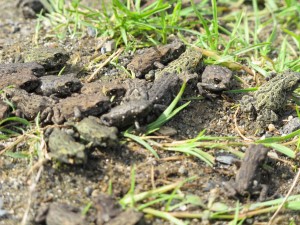 Given the myriad challenges facing wildlife in our province, one of the best things we can do to protect biodiversity in B.C. is to leave key habitat areas intact. As the global climate warms and precipitation patterns shift, having a complete ecosystem within which animals and plants can try to adapt will be essential, and frankly the least we can do given the dire situation many species are in.
Given the myriad challenges facing wildlife in our province, one of the best things we can do to protect biodiversity in B.C. is to leave key habitat areas intact. As the global climate warms and precipitation patterns shift, having a complete ecosystem within which animals and plants can try to adapt will be essential, and frankly the least we can do given the dire situation many species are in.
This is not news to the government, of course. For species ranging from mountain caribou to spotted owls and goshawks, the Ministry of Environment is quick to reference habitat loss as a contributing, if not the main, factor in population declines:
“human activities associated with resource extraction are the ultimate threats to caribou in British Columbia. Human development fragments and alters caribou habitat…“
“[The spotted owl] is at risk in this province because much of its habitat has been adversely affected by logging or lost due to land development.“
“The laingi subspecies of Northern Goshawk requires large areas of old-growth and mature forest. Large-scale timber harvesting removes much suitable nesting and foraging habitat… Because of this, the laingi subspecies is believed to be in jeopardy, and is on the British Columbia Red List.“
Likewise, the government cites habitat destruction as one of the greatest impacts on western toad populations in B.C.
“Development in and around wetlands can destroy or isolate populations.“
To a lesser extent, though still of importance, migrating toads are often killed by traffic as they try to cross roads.
Western toads are considered a species of conservation concern by the government of British Columbia and have been designated a status of special concern by the Committee on the Status of Endangered Wildlife in Canada (COSEWIC). In theory, they are protected under the B.C.’s Wildlife Act.
While BC has the most biodiversity in Canada, it is also one of two provinces (the other being Alberta) that has no provincial endangered species legislation. Sadly, BC is the home of more than 1,500 species currently at risk of extirpation or extinction.
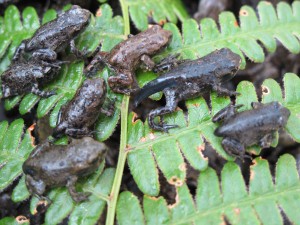 Summit Lake, just outside the village of Nakusp in the Kootenay region, is a key breeding area for western toads. Every year, usually around the end of August, young toadlets migrate from the shoreline of Summit Lake, across Highway 6, to upland habitat where they will live for four or five years before they return to the lake to breed. The mass migration sees upwards of a million little toads attempting the crossing, with tens of thousands getting run-over in the process.
Summit Lake, just outside the village of Nakusp in the Kootenay region, is a key breeding area for western toads. Every year, usually around the end of August, young toadlets migrate from the shoreline of Summit Lake, across Highway 6, to upland habitat where they will live for four or five years before they return to the lake to breed. The mass migration sees upwards of a million little toads attempting the crossing, with tens of thousands getting run-over in the process.
Hoping to help, nearby communities hold an annual Toadfest where people carrying the migrating western toads from the curb to the forest in buckets. The provincial government has also tried to address the problem by building directional fences leading to toad tunnels that allow the toads to safely cross under the highway. This amounts to an innovative solution and $200,000 investment in the protection of an increasingly threatened species. In the Ministry of Transportation and Infrastructure’s employee newsletter about their work they described the mass movement of western toads from Summit Lake to the forest as “among the great wildlife migrations in the world.”
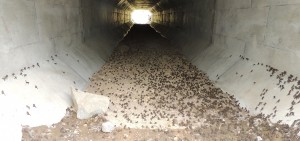 Unfortunately, the story doesn’t end there. After being safely escorted across the highway, via toad tunnel or bucket, the toads will now find themselves in a forest slotted for logging. Road building began last week and there are plans in the works to clear cut the 30 hectares where the toads hibernate.
Unfortunately, the story doesn’t end there. After being safely escorted across the highway, via toad tunnel or bucket, the toads will now find themselves in a forest slotted for logging. Road building began last week and there are plans in the works to clear cut the 30 hectares where the toads hibernate.
To their credit, the Nakusp and Area Community Forest (NACFOR) logging company has drafted a toad management plan and identified small habitat features that they’ll try to leave intact. I commend NACFOR for exploring ways in which they can continue to harvest the timber while also being mindful of this species of special concern, but it is really the government that should be in the leadership role here.
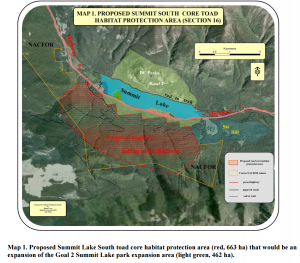 Protection of core terrestrial habitat – defined as “the spatial delineation of 95% of the population that encompasses terrestrial foraging, breeding, and overwintering habitats rather than buffers” – is seriously recommended in the scientific literature for amphibians (Semlitsch and Bodie 2003, Browne and Paszkowski 2010, Crawford and Semlitsch 2007). If the existing provincial park at Summit Lake were expanded to include the forest within roughly two kilometers of the lake the protection of core terrestrial habitat would likely be achieved, wildlife biologist Wayne McCrory said in his analysis of the situation.
Protection of core terrestrial habitat – defined as “the spatial delineation of 95% of the population that encompasses terrestrial foraging, breeding, and overwintering habitats rather than buffers” – is seriously recommended in the scientific literature for amphibians (Semlitsch and Bodie 2003, Browne and Paszkowski 2010, Crawford and Semlitsch 2007). If the existing provincial park at Summit Lake were expanded to include the forest within roughly two kilometers of the lake the protection of core terrestrial habitat would likely be achieved, wildlife biologist Wayne McCrory said in his analysis of the situation.
The province has been criticized for failing to set aside adequate habitat to protect caribou, spotted owls and goshawks and this toad situation illustrates just how reluctant the B.C. government is to remove forest from the logging land base. The key western toad forest habitat around Summit Lake is a relatively small, very specific area that could be included into the existing provincial park. This would represent a minor exemption from their 9,816 hectare total operating base.
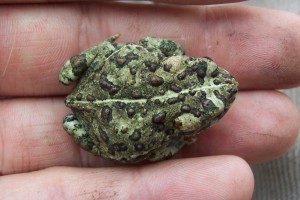 The creation of the toad tunnel represented an admirable step forward for the government’s approach to wildlife issues. Granting approval to log their core terrestrial habitat represents more of a smoking bulldozer ride back – squashing all their advancements in the process.
The creation of the toad tunnel represented an admirable step forward for the government’s approach to wildlife issues. Granting approval to log their core terrestrial habitat represents more of a smoking bulldozer ride back – squashing all their advancements in the process.
“Be an advocate for amphibians – protect toads and their habitat in your neighbourhood,” reads the government’s BC Frog Watch website.
Good advice, that I respectfully urge the BC government to follow by protecting western toad habitat around Summit Lake before it’s too late.

